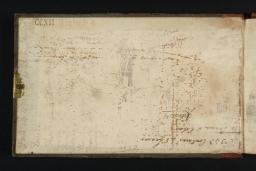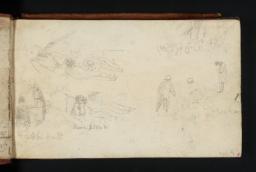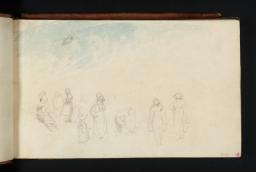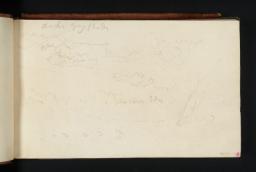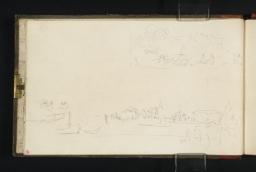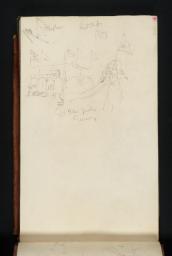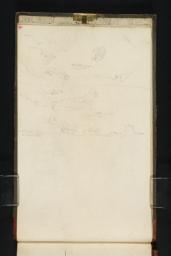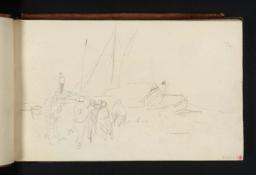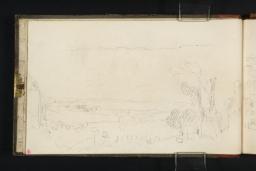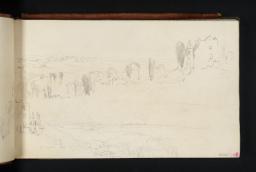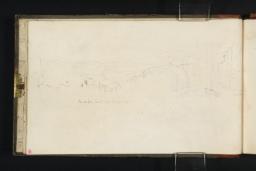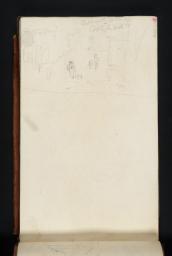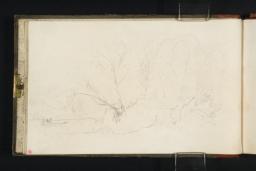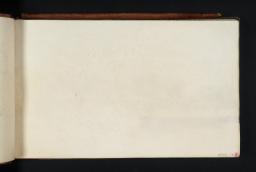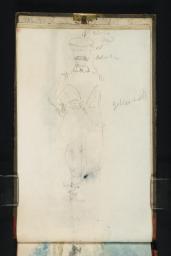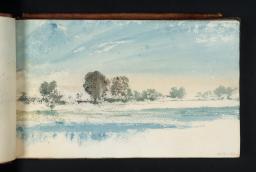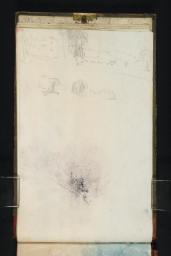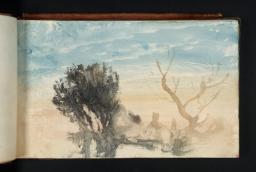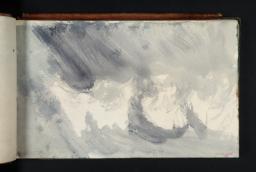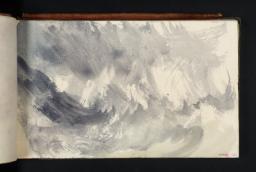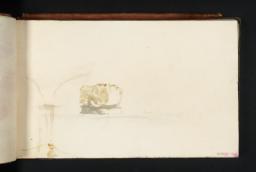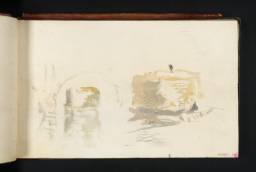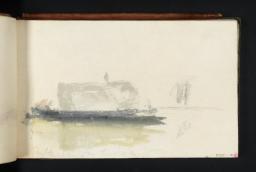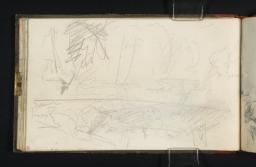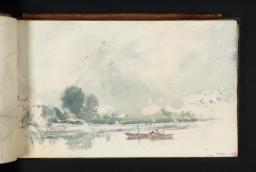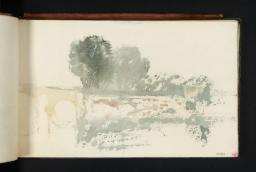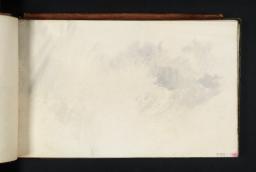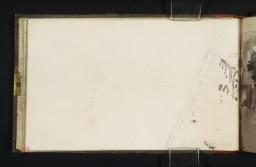Turner Bequest CCXII 1–91
Sketchbook, bound in boards, covered in grey paper quarter-bound over brown leather spine; one brass clasp, now missing
91 leaves and paste-downs of white wove paper, page size 114 x 188 mm; watermark ‘Allee | 1819’
Made by William Allee of Hurstbourne Prior Mill, Hampshire
Inscribed by Turner on a label on the spine in ink ‘Thames’ (now lost)
Numbered 343 as part of the Turner Schedule in 1854 and endorsed by the Executors of the Turner Bequest, inside front cover (D40969)
Inscribed in pencil ‘CCXII’ on back cover, bottom centre, upside down
Stamped in black ‘CCXII’ on front cover, top right
91 leaves and paste-downs of white wove paper, page size 114 x 188 mm; watermark ‘Allee | 1819’
Made by William Allee of Hurstbourne Prior Mill, Hampshire
Inscribed by Turner on a label on the spine in ink ‘Thames’ (now lost)
Numbered 343 as part of the Turner Schedule in 1854 and endorsed by the Executors of the Turner Bequest, inside front cover (D40969)
Inscribed in pencil ‘CCXII’ on back cover, bottom centre, upside down
Stamped in black ‘CCXII’ on front cover, top right
Accepted by the nation as part of the Turner Bequest 1856
Exhibition history
References
The identified pencil drawings in this sketchbook mainly comprise familiar vistas over the Thames Valley from Richmond Hill, and associated river scenes in the Richmond and Isleworth area. For the numerous sketches from the hill at both ends of the book, which would have informed two subsequent watercolours, see under folio 5 verso (D18603).
Finberg thought that the sketchbook was in use around 1825;1 later scholars have concurred, and the date is retained here for lack of any internal evidence to the contrary. Indeed, scribbled but evidently significant notes on folios 90 verso and 91 verso (D18703, D40972) are emphatically dated ‘Richmond 1825’. Unfortunately the last digit of the full date written twice on folio 47 recto (D18652) is difficult to make out, and both versions may be read as ‘June 25 1823’ or ‘1825’. That the weekdays and dates of the months in at least the first few tabulated entries of a scheme of payments noted inside the front cover (D40969) correspond to those in 1825 is another pointer to that year; see also the related calculations on folio 1 verso (D18596).
It has been suggested that drawings at the front and back were made on Turner’s tour of the Low Countries in August 1825,2 when he mainly used the Holland and Holland, Meuse and Cologne sketchbooks (Tate; Turner Bequest CCXIV, CCXV). See the sketches, mainly of figures and shipping (some of which could equally have been observed along the Thames, and some of which share pages with identified Thames subjects), inside the front cover and on folios 1 recto, 2 recto, 3 recto and verso and 5 recto (D40969, D18595, D18597–D18599, D18602) and then on folios 87 recto, 89 recto and verso, 90 verso, 91 recto and verso and inside the back cover (D18697, D18700, D18701, D18703, D18704, D40972, D40973).
As Ian Warrell has observed, 1825 was the last full summer the artist could have spent at Sandycombe Lodge,3 his self-designed country villa at Twickenham (see the Introduction to the ‘Sandycombe Lodge c.1808–1812’ section of the present catalogue). Despite his longstanding attachment to the area, Turner sold the house for practical reasons on 19 June 1826,4 having always retained his central London residence with its studio and gallery. Much of the first half of the book is taken up with twenty-five full-page watercolour studies which appear to be Thames Valley subjects in spirit if not in their precise topography, on the rectos of folios 9–31, 33 and 34 (D18609, D18611, D18613–D18618, D18620–D18631, D18633–D18635, D18637, D18638). D18623 is continued a little way onto folio 19 verso opposite (D40970), while D18633 is superimposed on a pencil sketch, the other half of which, on folio 28 verso (D18632), was left uncoloured; this double-page drawing may have preceded the watercolour sequence and be unrelated to it. Watercolour was also used more sparingly at the beginning and end of the book, on folio 2 recto (D19597) and, apparently, on folio 91 recto (D18704).
David Hill has described some of the colour subjects as composed of ‘evanescent washes, almost Chinese in style and ethereal’, suggesting that they are ‘in many respects a way of not engaging with reality, of transcending it, of letting go, of being able to say goodbye’5 to Turner’s time by the rural river. More prosaically, Gerald Wilkinson thought most of them, with their ‘direct, broad brushwork’, ‘unexciting – but nice’.6 Eric Shanes has considered their technical means, as showing ‘the degree to which Turner could explore remembered or imagined landscapes in his sketchbooks wholly in terms of colour’ through ‘extremely vivacious watercolour sketches of river scenery. In many of them Turner took advantage of the slight resistance of the paper to certain pigments. Such a speckling of the colours can be seen to great advantage in the page on display, for it lends enormous sparkle to the scene depicted.’ Shanes has also observed that as with ‘many of Turner’s sketchbooks in which he worked up colour sketches and studies, the absence of any pigment or staining on the opposite pages shows that he took a patient approach to making such works, waiting for each page to dry before starting the next one’.7 With regard to these perhaps deceptively spontaneous compositions, John Gage has noted ‘Turner’s need to be specific, his care for controlled expression’, such that in effect ‘the element of improvisation is minimal’.8
There are studies of ceremonial barges on folios 4 recto, 71 verso and apparently 72 recto (D18600, D18679, D18680). The later two include river landscapes typical of the pencil sketches scattered through the book apart from the Richmond Hill views; some are identified as being around Isleworth and the adjacent Syon Park and Kew, and others are no doubt along nearby reaches of the Thames at Richmond and Twickenham. See folios 3 verso, 7 recto and verso, 10 verso, 16 verso, 46 verso, 47 recto, 49 verso, 69 verso–70 recto, 75 verso and 91 verso (D18599, D18606, D18607, D18612, D18619, D18651, D18652, D18655, D18676–D18677, D18684, D40972). Otherwise, there are typically miscellaneous studies of sunsets, a working barge, a hussar officer (perhaps sketched strolling on Richmond Hill), the sails of a Thames barge, and shipping near St Paul’s Cathedral (folios 4 verso, 5 recto, 9 verso, 32 recto, 81 verso; D18601, D18602, D18610, D18636, D18691). Meanwhile, Turner’s instinctive tendency to idealise or classicise his Thames subjects is seen in his thumbnail study for a river or seaport composition on folio 47 verso (D40971); see also folio 20 recto (D18623).
Finberg recorded a label (since lost) ‘on back–“Thames.”’9 Like those which survive on other sketchbooks, this was presumably in ink on a white wove paper label pasted onto the spine. David Hill initially suggested that Turner devised his sequence of numbered and annotated labels during a general review of the sketchbooks in about 1821 or 1822,10 later revising this to the second half of 1824 on the dating evidence of some of the relevant books.11 Ian Warrell has subsequently reasoned that the process began in 1823, ending in the summer of 1824,12 which may cast a little doubt on the conventional dating of the present book; perhaps, since the label did not apparently include a number, Turner continued the practice in a modified form. Finberg also noted John Ruskin’s comments on a separate wrapper: ‘343. Slight experiments in colour on white paper.’13
See Patrick Youngblood, ‘The Painter as Architect: Turner and Sandycombe Lodge’, Turner Studies, vol.2, no.1, Summer 1982, p.33.
See David Hill, ‘The Landscape of Imagination and the Sense of Place: Turner’s Sketching Practice’ in Maurice Guillaud, Nicholas Alfrey, Andrew Wilton and others, Turner en France, exhibition catalogue, Centre Culturel du Marais, Paris 1981, pp.143, 147 note 34.
Technical notes
How to cite
Matthew Imms, ‘Thames Sketchbook c.1825’, sketchbook, December 2014, in David Blayney Brown (ed.), J.M.W. Turner: Sketchbooks, Drawings and Watercolours, Tate Research Publication, April 2015, https://www

